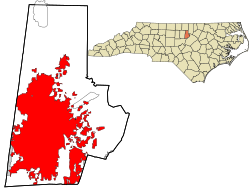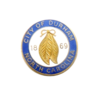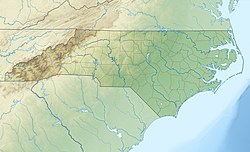
Back Dūnholm (Norþcarolīna) ANG درم (كارولاينا الشمالية) Arabic دورام (نورث كارولاينا) ARZ Durham (Şimali Karolina) Azerbaijani دورهام، قوزئی کارولینا AZB Дарэм (Паўночная Караліна) Byelorussian Дарэм (Паўночная Караліна) BE-X-OLD Дърам (Северна Каролина) Bulgarian ডারাম, নর্থ ক্যারোলাইনা Bengali/Bangla Durham (North Carolina) Breton
Durham | |
|---|---|
Durham skyline Baldwin Auditorium in Duke University Unity monument at Bennett Place | |
|
| |
| Nickname(s): | |
 Location in Durham County and North Carolina | |
| Coordinates: 35°58′43″N 78°54′00″W / 35.97861°N 78.90000°W | |
| Country | United States |
| State | North Carolina |
| Counties | Durham, Wake, Orange[1] |
| Incorporated | April 10, 1869[4] |
| Named for | Bartlett S. Durham |
| Government | |
| • Type | Council–manager |
| • Body | Durham City Council |
| • Mayor | Leonardo Williams (D) |
| • City Manager | Wanda Page |
| • Council | Members[5]
|
| Area | |
| • Total | 116.19 sq mi (300.92 km2) |
| • Land | 115.36 sq mi (298.79 km2) |
| • Water | 0.82 sq mi (2.13 km2) 0.71% |
| Elevation | 404 ft (123 m) |
| Population (2020) | |
| • Total | 283,506 |
| • Estimate (2022) | 291,928[8] |
| • Rank | 71st in the United States 4th in North Carolina |
| • Density | 2,457.51/sq mi (948.85/km2) |
| • Urban | 396,118 (US: 106th) |
| • Urban density | 2,160.4/sq mi (834.1/km2) |
| • Metro | 608,879 (US: 94th) |
| Demonym | Durhamite |
| Time zone | UTC−5 (EST) |
| • Summer (DST) | UTC−4 (EDT) |
| ZIP codes | 27701, 27702, 27703, 27704, 27705, 27706, 27707, 27708, 27709, 27710, 27711, 27712, 27713, 27715, 27717, 27722 |
| Area code(s) | 919, 984 |
| FIPS code | 37-19000[10] |
| GNIS feature ID | 2403521[7] |
| Primary Airport | Raleigh–Durham International Airport |
| Public transportation | GoDurham |
| Website | durhamnc |
Durham (/ˈdʌrəm/ DURR-əm)[11] is a city in the U.S. state of North Carolina and the county seat of Durham County.[12] Small portions of the city limits extend into Orange County and Wake County. With a population of 283,506 in the 2020 census, Durham is the 4th-most populous city in North Carolina, and the 71st-most populous city in the United States.[8] The city is located in the east-central part of the Piedmont region along the Eno River. Durham is the core of the four-county Durham-Chapel Hill, NC Metropolitan Statistical Area, which had an estimated population of 608,879 in 2023. The Office of Management and Budget also includes Durham as a part of the Raleigh-Durham-Cary, NC Combined Statistical Area, commonly known as the Research Triangle, which had an estimated population of 2,368,947 in 2023.[9]
A railway depot was established in 1849 on land donated by Bartlett S. Durham, the namesake of the city. Following the American Civil War, the community of Durham Station expanded rapidly, in part due to the tobacco industry. The town was incorporated by act of the North Carolina General Assembly, in April 1869. The establishment of Durham County was ratified by the General Assembly 12 years later, in 1881. It became known as the founding place and headquarters of the American Tobacco Company. Textile and electric power industries also played an important role. While these industries have declined, Durham underwent revitalization and population growth[13] to become an educational, medical, and research center.[14]
Durham is home to several recognized institutions of higher education, most notably Duke University and North Carolina Central University. Durham is also a national leader in health-related activities, which are focused on the Duke University Hospital and many private companies. Duke and its Duke University Health System are the largest employers in the city. North Carolina Central University is a historically black university that is part of the University of North Carolina System. Together, the two universities make Durham one of the vertices of the Research Triangle area; central to this is the Research Triangle Park[15] south of Durham, which encompasses an area of 11 square miles and is devoted to research facilities.
On the Duke University campus are the neo-Gothic Duke Chapel and the Nasher Museum of Art. Other notable sites in the city include the Museum of Life and Science, Durham Performing Arts Center, Carolina Theatre, and Duke Homestead and Tobacco Factory. Bennett Place commemorates the location where Joseph E. Johnston surrendered to William T. Sherman in the American Civil War. The city is served, along with Raleigh, by Raleigh–Durham International Airport.
- ^ "Durham Maps". durhamnc.gov. City of Durham. Retrieved June 22, 2023.
- ^ "Durham was nicknamed the "Bull City" in the late 1800s when the Blackwell Tobacco Company named its product "Bull" Durham Tobacco". durhamnc.gov. January 17, 2021. Archived from the original on September 5, 2015.
- ^ "About Durham". Archived from the original on October 22, 2009. Retrieved October 9, 2009.
- ^ Durham (N.C.) – Directories. Richmond, Virginia: Hill Directory Company. 1923. p. 7. Retrieved May 13, 2010.
- ^ "City Council". durhamnc.gov. December 7, 2023. Retrieved December 7, 2023.
- ^ "ArcGIS REST Services Directory". United States Census Bureau. Retrieved September 20, 2022.
- ^ a b U.S. Geological Survey Geographic Names Information System: Durham, North Carolina
- ^ a b "QuickFacts: Durham city, North Carolina". United States Census Bureau. Retrieved September 14, 2022.
- ^ a b "Metropolitan and Micropolitan Statistical Areas Population Totals: 2020-2023". United States Census Bureau, Population Division. March 14, 2024. Retrieved March 15, 2024.
- ^ "U.S. Census website". United States Census Bureau. Retrieved January 31, 2008.
- ^ "NC Pronunciation Guide". Wral.com. Retrieved August 15, 2022.
- ^ "Find a County". National Association of Counties. Retrieved June 7, 2011.
- ^ Willets, Sarah (August 29, 2018). "To Keep Up With Growth, Durham Needs to Add Two Thousand Housing Units a Year. Its Rules Are in the Way". INDY Week. Archived from the original on August 19, 2021. Retrieved June 20, 2019.
- ^ "Durham | North Carolina, United States". Encyclopedia Britannica. Retrieved June 20, 2019.
- ^ "Where is RTP?". Research Triangle Foundation of North Carolina. Archived from the original on November 4, 2007. Retrieved October 9, 2007. The Herald Sun reports that it is the 4th smartest city in the US.
© MMXXIII Rich X Search. We shall prevail. All rights reserved. Rich X Search










